When the monumental Ice Age finds from Giant Cement in Harleyville South Carolina first hit the paleo news, I scrounged to see any photos and hear accounts from anyone who had seen it. Tales of armed guards and despicable looters floated amongst the newsgroups and local fossil hunter rumor mill. I clipped newspaper and magazine articles, digesting every bit of information I could, but there wasn't much out there. I was possessed to learn more than the mainstream sources could ever hope to provide. How often does a find of enough scientific significance to be published in national news happen right in my own back yard? Never since I can remember. Then out of the blue, local fossil legend Vance McCollum contacted me and we started emailing back and forth. He awed me with his stories of Camelot, and all I could utter were platitudes like, "That must have been great! I wish I could have seen it." It was pathetic, but how can anything I've ever found compare to the glory he's seen out there? It couldn't, so I didn't even try. I don't know what brought it about, but he invited me to go in on a dig and see the site. The rules were that everything I found would have to go to the SC State Museum, and I couldn't tell a soul (until now!); I agreed without a moment's hesitation. I took my last 3 days of vacation for the year so I could spend as much time there as possible.
The first day of the dig was impossibly slow to come, so when it finally came, I arrived early so there would be a little time to hunt shark teeth first, but the meat of the day was to dig on a site that is a first in South Carolina history. The mine dispatched heavy equipment to the site to remove the overburden that was pushed over the site as a precaution against looters. Some of us went to work setting up a grid as we probed to find the fossil vein. When we found none, we removed a portion of overburden and started the process anew. Since we knew about where remains of a sloth lay, we concentrated our search. Finally, we reached the bag that Vance had placed over a giant sloth ball joint the last time he was here. We traded our shovels for trowels as we revealed more and more of a bone mass. The sloth formed a cage that trapped other animals that rinsed past in a flood. While in a state of fossil hunting euphoria, I imagined:
One fateful day 400,000 years ago, we'll call it a Tuesday, residents of Irvingtonian pleistocene South Carolina were going about their business. Deer were grazing, turtles were slowly plodding across the ground. Bobcats, Lynx, Wolves and other predators hunted. Giant Sloths used their enormous claws to dine on low hanging tree limbs. Cheetas, Giant Beavers the size of grizzly bears, and other amazing but long since extinct fauna called South Carolina home. Even a multitude of Camels called this area home. A catastrophic flash flood swept across the landscape with such force that it carved deep sections of the earth all the way down to sediments deposited over 40 million years prior. As the flood waters receeded, the extent of the devastation became more evident. The bodies of the victims lie in broken, lifeless masses.
Awakened from my daydream by yet another discovery, I continued to dig, excited to see the next smooth, deep brown surface of some new bone appear from the pure white sand that was a crypt for so many. We uncovered remains of turtle, bobcat, rodent, camel, deer, horse, and others throughout the rest of the day; all incredibly preserved together in a mass that rested atop a 300 pound sloth pelvis. Cast after cast was made to remove the delicate fossils. Dispersed amongst the bones were shark teeth that were eroded from their Eocene resting places by the extremely turbulent flood. In all, two whole days were spent carefully removing all the fragile fossils in the bone mass.
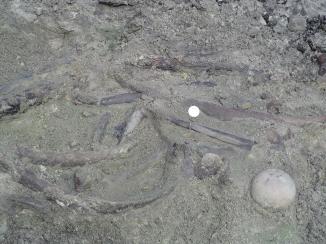
With the last of the fossils in the mass was removed, it was time to move the operations eastward. The giant mining machinery exposed virgin ground, and no one knew what to expect. The crew was finally able to spread out and take advantage of extra shovels. The finds started almost right away. More teeth and bones from the sloth were first to be found. Some horse leg bones and a juvenile deer jaw followed. Locations were carefully noted so scientists could determine where in the grid each fossil was found.
We started to fear that we had reached the end of the bonebed when no one made a find in over 45 minutes. One of the other volunteers hit a bone that looked promising. We all watched as the complete lower jaw section of a Saber Toothed Cat was revealed. We all took turns admiring the completeness of the specimen. A tiny tooth just behind the front incisor was a real treat as this position is integral in identifying the species.
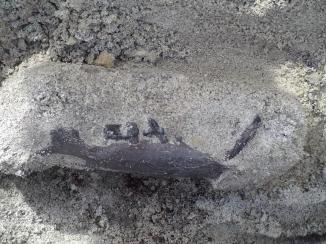
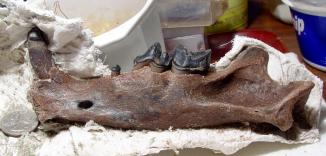
The rare fossil was carefully jacketed and removed. We had all paused to enjoy the victory, but we soon went back to work excavating new areas of the dig site. For nearly an hour, I found nothing but more sand. Then I felt my small probe hit something solid. Because we were digging so close to the eocene deposits, I thought that I had simply hit a big chunk of the Santee Limestone. Still, though, I dug carefully to avoid breaking anything important. I carefully removed the overburden with a small trowel. As I came within a few centimeters of the unknown object, I began to scrape the sand away with a butter knife. The hole was very small at this point, but my butter knife finally touched the object. From the sound I could definitely tell it was bone and not limestone. It was time to remove the overburden so I could safely uncover the whole object. Excitedly I removed the sugar-like sand with a shovel until the area just above the fossil was completely flat. With the butter knife, I scraped away more sand to reaveal a curved object that really was starting to resemble a whale tooth or a small rib bone. Archaeocete whale teeth are sometimes found in the Eocene deposits, and since this fossil was on top of the eocene layer, we really thought it could be a whale tooth. The other diggers were disinterested at that point and went about their own quarries, eagar for more auspicious finds. I uncovered one end of the fossil entirely, and I eliminated the possibility of it being a whale tooth. I really thought it was a rib until I began to expose the other end of the fossil. I started at the center and less than a centimeter where I first exposed the fossil I began to see a shine. It was much too shiny for bone so I began to be excited again. I carefully brushed away a little more sand and saw a flattened, sharp enameled edge. The root was over 4 inches long before it gave way to the enamel. I only know of one fossil that can be found in South Carolina, but I didn't want to say it. I uncovered a little more of the fossil and it kept on going. I reached the dagger tip and I knew exactly what it was - a Saber Cat tooth. A glorious, complete saber cat tooth. Intact from end to end. By now, everyone at the dig site was crowded around to see the find of the day. I stepped back in pride to admire the ultimate find of SC fossil hunting. I snapped a few photos and let more experienced jacketers remove the piece.
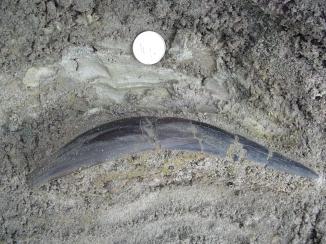
It was the first complete Saber Cat saber found at the site! Excitement filled the air. Knowing that the chances of matching a find of this magnitude were slim, I decided to go do some shark tooth hunting around the dig site. Here's pic of the bounty of
Eocene Shark's Teeth from Giant Cement. During my exploration, besides for loads of fossil shark's teeth, I unwittingly stumbled upon another first for the site, a Giant Beaver tooth fragment. I found it around 50 yards from the dig site and it was a different color, but it was nevertheless important, as there had been no Giant Beaver fossils found at the Camelot site yet. I excitedly returned to the dig site where I had found the Saber Cat saber earlier in the day. I showed off the Giant Beaver incisor fragment, and the professionals were impressed that my hunt for shark teeth had turned up something valuable. Of course, it was hard for them to get too excited about it because in my absence, they had made another discovery. It turns out that the clump of sand and dirt that I used as a seat during the excavation of the saber housed another important find, a Saber Cat skull with both upper jaws intact. I saw it just before it was jacketed, and it was amazing to behold! The most intriguing fact about it was that
both of its sabers were intact, though most of the enameled portions had long ago snapped off and been lost. That means that the saber I found earlier belonged to another cat. How many of these mighty creatures must have lived here if the remains of two different individuals were found within a 1 meter radius?
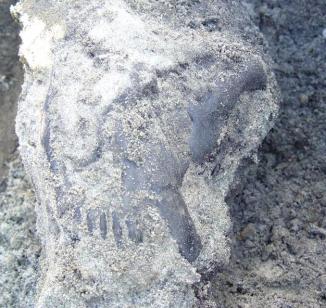
Our little group was only allowed three days to dig on the site, and then the area was covered back with tons of overburden to foil looters. During the three days amazing finds were recovered for the South Carolina State Museum. We found the remains of Giant Sloth, Deer, Camel, Giant Beaver, Saber Cat, Lynx, Turtle, and more. None of us could have imagined the success of the dig before be began, but the results were astounding. The fossils are still being prepared and studied, though some are complete and currently on display at the SC State Museum in Columbia. As far as I know, this site is closed and is no longer producing any fossils, but one source told me that the Camelot site was the second largest find in United States history outside of Florida for this time period, and information learned from it greatly added to the pool of knowledge about South Carolina's complex ecosystem 400,000 years ago.
One final note: Safety is the paramount concern of the quarry owners. Giant has very limited individual visitation, by invitation only. Absolutely no one should call the quarry to ask permission to collect there, and in addition, collecting privileges are granted by another office, not at the quarry. Trespassers will be immediately arrested and prosecuted. I was a guest of the S.C. State Museum and all fossils collected at the Camelot site are permanently housed at the State Museum.